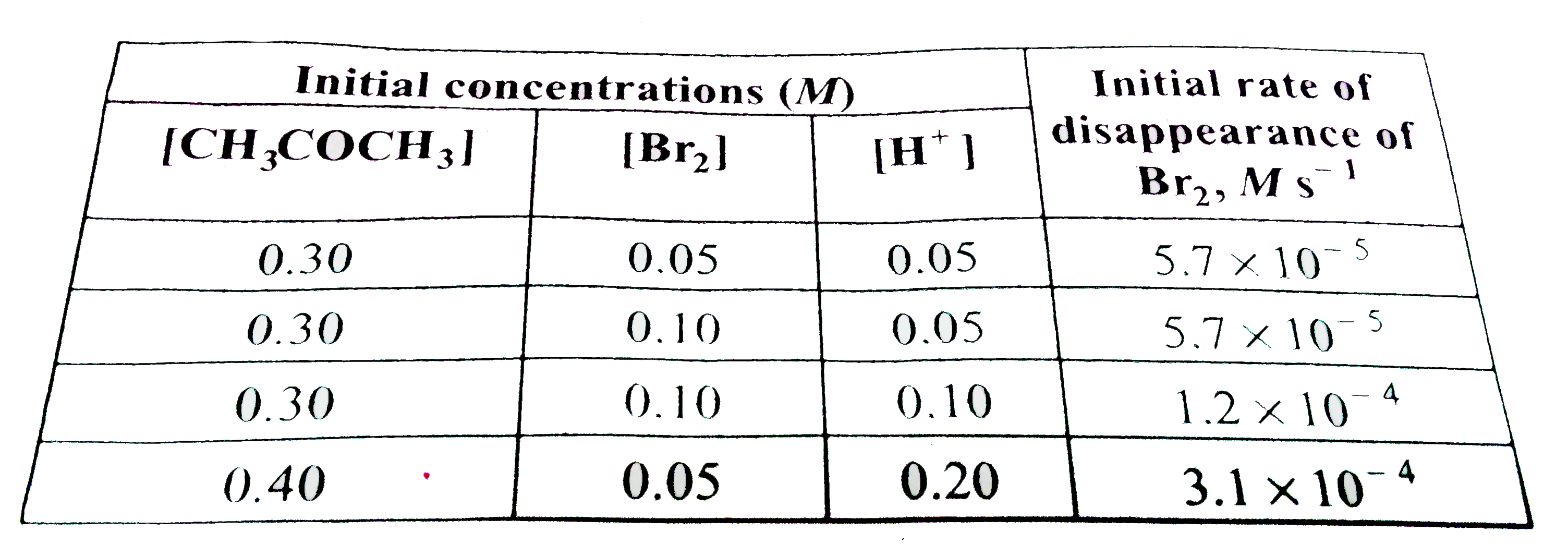The bromination of acetone that occurs in acid solution is represented by this equation.
CH3COCH3(aq)+Br2(aq)→
CH3COCH2Br(aq)+H+(aq)+Br(aq)
These kinetic data were obtained for given reaction concentrations.
Initial concentration, M
[CH2COCH3][Br2][H+](Initail rate) (disappearance of Br2)0.300.050.055.7×10−50.300.100.055.7×10−50.300.100.101.2×10−40.400.50.203.1×10−4
rate=K[CH2COCH3][H+]
rate=K[CH2=COCH3[Br2]
rate=K[CH3COCH3][Br2][H+]2
rate=k[CH3COCH3][BR2][H+]
The correct Answer is:A
Let the order of reaction wrt CH3COOCH3.Br2andH+arex,y,andz respectively thus .
Rate(I)=[CH3COCH3]x[Br2]y[H+]z
4.7×10−5=(0.30)x(0.05)y(0.05)z
5.7×10−5=(0.30x(0.10)y(0.05)z
1.2×10−4=(0.30)x(0.10)y(0.10)z
3.1×10−4=(0.40)x(0.05)y(0.20)z
from Eqs (i) and(ii)
1=(12)yor1∘=(12)y
y=0
from Eqs(ii) and (iii)
z=1
from Eqs.(i) and (iv)
x=1
thus rate law∝|CH2COCH3|1|Br2|0[H+]1
=K[CH3COCH3][H+]
Topper's Solved these Questions
Similar Questions
The bromination of acetone that occurs in acid solution is represented by
CH3COCH3(aq.)+Br2(aq.)→CH3COCH2Br(aq.)+H+(aq.)+Br−(aq.)
These kinetic data were obtained for given reaction concentration
Initial concentration
Initial concentrationInitial rate ofdisappearance[CH3COCH3][Br2][H+]of Br20.300.050.055.0×10−50.300.100.55.0×10−50.300.100.101.0×10−40.900.050.103.0×10−4
Based on these data, order of reaction will be -View SolutionThe bromination of acetone that occurs in acid solution is represented by this equation
CH3COCH3(aq)+Br2(aq)→CH3COCH2Br(aq)+H+(aq)+Br−(aq)
These kinetic data were obtained for given reaction concentrations .Initial concentrations , M
[CH3COCH3][Br2][H+]0.300.050.050.300.100.050.300.100.100.400.050.20
Initial rate , disappearance of Br2,Ms−1View Solution
Knowledge Check
- Question 1 - Select One
The bromination of acetone that occurs in acid solution is represented by this equation.
CH3COCH3(aq)+Br2(aq)→
CH3COCH2Br(aq)+H+(aq)+Br(aq)
These kinetic data were obtained for given reaction concentrations.
Initial concentration, M
[CH2COCH3][Br2][H+](Initail rate) (disappearance of Br2)0.300.050.051.5×10−50.300.100.055.7×10−50.300.100.101.2×10−40.400.50.203.1×10−4Arate =k[CH3COCH3][Br2]Brate =k[CH3COCH3][Br2][H+]2Crate =k[CH3COCH3][Br2][H+]Drate =k[CH3COCH3][H+] - Question 2 - Select One
The bromination of acetone that occurs in acid solution is represented by
CH3COCH3(aq.)+Br2(aq.)→CH3COCH2Br(aq.)+H+(aq.)+Br−(aq.)
These kinetic data were obtained for given reaction concentrations :

Based on these data, rate equations is :ARate=k[CH3COCH3][Br2][H+]2BRate=k[CH3COCH3][Br2][H+]CRate=k[CH3COCH3[H+]DRate=k[CH3COCH3[Br2] - Question 3 - Select One
The bromination of acetone that occurs in acid solution is represented by this equation.
CH3COCH3(aq)+Br2(aq)→CH3COCH2Br(aq)+H+(aq)+Br−(aq)
These kinetic data were obtained for given reaction concentrations.
[CH3COCH3][Br2][H+]rate of disappearance of Br2,(Ms−1) 0.300.050.05 5.7×10−5 0.300.100.05 5.7×10−5 0.300.100.10 1.2×10−4 0.400.050.20 3.1×10−4
Based on these data, the rate equation isARate=k[CH3COCH3][Br2][H+]2BRate=k[CH3COCH3][Br2][H+]CRate=k[CH3COCH3][H+]DRate=k[CH3COCH3][Br2]
The bromination of acetone that occurs in acid solution is represented by
CH3COCH3(aq.)+Br2(aq.)→CH3COCH2Br(aq.)+H+(aq.)+Br−(aq.)
These kinetic data were obtained for given reaction concentrations :

Based on these data, rate equations is :View SolutionThe bromination of acetone which occurs in acid solution is represented by the equation:
CH3COCH3(aq)+Br2(aq)→CH3COCH2Br(aq)+H+(aq)+Br−1(aq)
The following kinetic data was obtained for the given reaction concentration:

Initial rates of disappearance of of Br2(Ms−1
5.7×10−5,5.7×10−5
1.2×10−4,3.1×10−4
Based on these data, the rate equation is:View SolutionConisder the reaction represented by the equation:
CH3Cl(g)+H2O(g)→CH3OH(g)+HCl(g)
These kinetics data were obtained for the given reaction concentrations:
Initial conc (M)Initial rate of disappearance[CH3Cl][H2O]of CH3Cl(Ms−1)0.20.210.40.220.40.48
Order with respect to [CH3Cl] will beView SolutionConisder the reaction represented by the equation:
CH3Cl(g)+H2O(g)→CH3OH(g)+HCl(g)
These kinetics data were obtained for the given reaction concentrations:
Initial conc (M)Initial rate of disappearance[CH3Cl][H2O]of CH3Cl(Ms−1)0.20.210.40.220.40.48
The rate law for the reaction will beView SolutionConisder the reaction represented by the equation:
CH3Cl(g)+H2O(g)→CH3OH(g)+HCl(g)
These kinetics data were obtained for the given reaction concentrations:
Initial conc (M)Initial rate of disappearance[CH3Cl][H2O]of CH3Cl(Ms−1)0.20.210.40.220.40.48
Unit of rate constant will beView Solution

